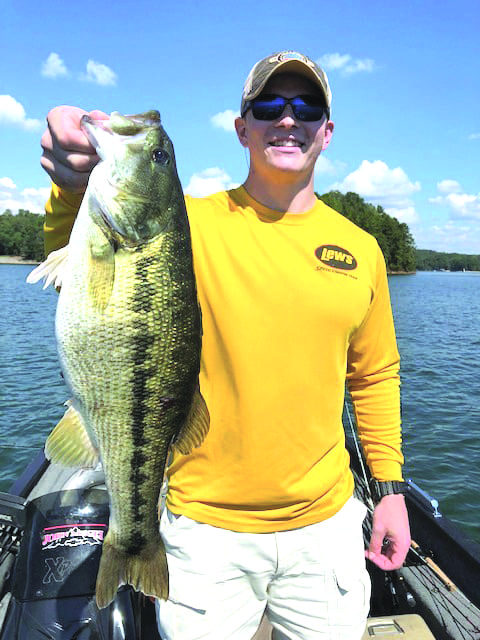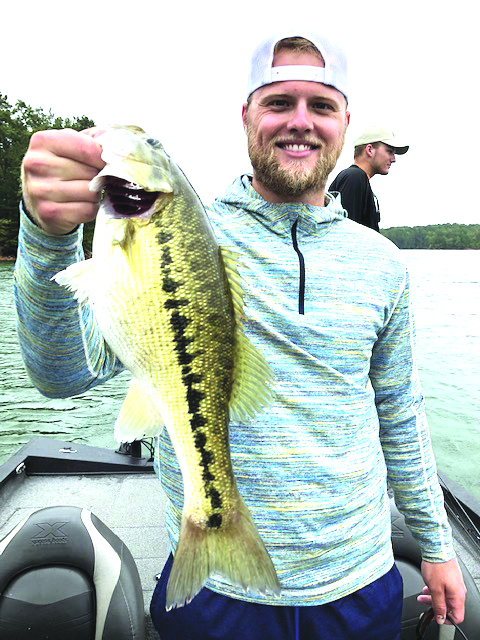by Jimbo Mathley
Many anglers make the common mistake of underestimating the viability of late fall and winter fishing. While the outside elements are not always favorable, the months of November and December on Lake Lanier can offer anglers some of the best fishing of the year. With the warmer than normal October we have experienced this year, November should be a month of transition on the lake. Ditch fishing is my normal prognostication this time of year, however, this bite may be delayed this year due to the warmer weather we have been experiencing.
This year, given the warmer than normal October, the transition of the fish deeper into the creeks and the creek ditches may be delayed. I look for the structure bite on points and humps around the mouths of the major creeks to remain strong into November. Look for good schooling activity in mornings as well as throughout the day in these types of areas. The topwater and swimbait bite should extend into November, which is a good thing! Stay flexible as weather fronts will affect the location and mood of the catchable fish. Don’t forget to look shallow around these points and humps. A spinnerbait on windy days can be incredible this time of year fished shallow on points. Also a big swimbait, like the Sweet Bait Sweet Herring can be an excellent choice for a big catch. As we proceed with this article, I will address more of how to approach once the water gets around 60 degrees, which may or may not happen in November this year.
Shallow Ditches: Oftentimes, if you find a shallow ditch (15 feet or less) in a creek, you will find baitfish present in and around this ditch. Bass will show up and feed in these areas, particularly in low-light conditions, even in the dead of winter. Slow-rolling a SuperSpin or slow cranking a crankbait in these areas at daylight is a great way to take some huge spots throughout the late fall and winter. Present a SPRO jerkbait over these same areas for bites as well. Cast your jerkbait long distances over the ditch and work the bait back to the boat with a jerk, jerk, pause retrieve. Include long pauses of up to 10 seconds between jerks. Also, ensure that you jerk the bait on slack line to improve the erratic action of the bait, which will trigger more strikes. The key to this technique is patience. Long pauses can be the key.

Steep Rock Banks/Rip Rap: These features consistently hold fish during the late fall and winter months. These “vertical” banks, present both in the creeks as well as the main lake, offer the fish the ability to change depths within the water column without traveling very far. This provides an optimal situation for the fish whose metabolism and activity levels are slowed by the colder water. Begin by using your electronics to graph a likely area in search of bait. When you find the bait, you can rest assured that fish are somewhere in the area. Search for changes in the structure as your starting place. Look for points, pockets, contour changes or transition areas where sand meets rock or clay, for example. Begin your prospecting in these areas with a SPRO jerkbait such as a McStick. Impart the jerk, jerk, pause retrieve mentioned previously, with a focus on long pauses. If the fish are not active enough to hit the jerkbait, try worms or Chattahoochee jigs worked slowly down the rock bank. Position your boat in deeper water and cast towards the bank. Work the bait slowly and methodically back to the boat, paying particular attention to your lure’s movements. Bites in the late fall and winter are often VERY subtle. Once you detect something unusual in your lure’s action, set the hook.
While these areas are not the only possible places to find fish on Lake Lanier in the late fall, they are some very good areas to begin your search. Remember to look for bait and fish in an area before fishing it. Fish where the fish are! Good luck out there and see you on the water!
For more information or to book a trip, contact Jimbo on Lanier via email: jim@laniermapped.com or phone: 770-542-7764. Check out Jimbo’s website: www.jimboonlanier.com.
